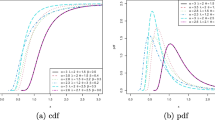Abstract
It is known that the tail index of a GARCH model is determined by a moment equation, which involves the underlying unknown parameters of the model. A tail index estimator can therefore be constructed by solving the sample moment equation with the unknown parameters being replaced by its quasi-maximum likelihood estimates (QMLE). To construct a confidence interval for the tail index, one needs to estimate the non-trivial asymptotic variance of the QMLE. In this paper, an empirical likelihood method is proposed for interval estimation of the tail index. One advantage of the proposed method is that interval estimation can still be achieved without having to estimate the complicated asymptotic variance. A simulation study confirms the advantage of the proposed method.
Similar content being viewed by others
References
Basrak B, Davis RA, Mikosch T (2002) Regular variation of GARCH processes. Stoch Process Appl 99:95–115
Berkes I, Horváth L, Kokoszka P (2003a) Estimation of the maximal moment exponent of a GARCH(1,1) sequence. Econom Theory 19:565–586
Berkes I, Horváth L, Kokoszka P (2003b) GARCH processes: structure and estimation. Bernoulli 9:201–207
Chen SX, Van Keilegom I (2009) A review on empirical likelihood methods for regression. Test 18:415–447
Cont R, Tankov P (2004) Financial modeling with jump processes. Chapman and Hall, New York
De Haan L, Ferreira A (2006) Extreme value theory: an introduction. Springer, New York
Drees H (2000) Weighted approximations for tail processes for β-mixing random variables. Ann Appl Probab 10:1274–1301
Goldie CM (1991) Implicit renewal theory and tails of solutions of random equations. Ann Appl Probab 1:126–166
Hall P, Heyde CC (1980) Martingale limit theory and its application. Academic Press, New York
Hall P, Yao Q (2003) Inference in ARCH and GARCH models. Econometrica 71:285–317
Hill BM (1975) A simple general approach to inference about the tail of a distribution. Ann Stat 3:1163–1174
Iglesias EM, Linton OB (2009) Estimation of tail thickness parameters from GJR-GARCH models. Working Paper 09-47, Economic Series (26), Universidad Carlos III de Madrid
Kesten H (1973) Random difference equations and renewal theory for products of random matrices. Acta Math 131:207–248
Ling S (2007) Self-weighted and local quasi-maximum likelihood estimators for ARMA-GARCH/IGARCH models. J Econom 140:849–873
Mikosch T, Stărică C (2000) Limit theory for the sample autocorrelations and extremes of a GARCH(1,1) process. Ann Stat 28:1427–1451
Mikosch T, Straumann D (2006) Stable limits of martingale transforms with application to the estimation of Garch parameters. Ann Stat 34:493–522
Nelson DB (1990) Stationary and persistence in GARCH(1,1) models. Econom Theory 6:318–334
Owen AB (1990) Empirical likelihood confidence regions. Ann Stat 18:90–120
Owen AB (2001) Empirical likelihood. Chapman and Hall, New York
Qin J, Lawless J (1994) Empirical likelihood and general estimating equations. Ann Stat 22:300–325
Quintos C, Fan Z, Phillips PCB (2001) Structural change tests in tail behaviour and the Asian crisis. Rev Econ Stud 68:633–663
Straumann D, Mikosch T (2006) Quasi-MLE in heteroscedastic time series: a stochastic recurrence equations approach. Ann Stat 34:2449–2495
Taylor SJ (2005) Asset price dynamics, volatility, and prediction. Princeton University Press, Princeton
Author information
Authors and Affiliations
Corresponding author
Additional information
Communicated by Domingo Morales.
Rights and permissions
About this article
Cite this article
Chan, N.H., Peng, L. & Zhang, R. Interval estimation of the tail index of a GARCH(1,1) model. TEST 21, 546–565 (2012). https://doi.org/10.1007/s11749-011-0264-0
Received:
Accepted:
Published:
Issue Date:
DOI: https://doi.org/10.1007/s11749-011-0264-0




